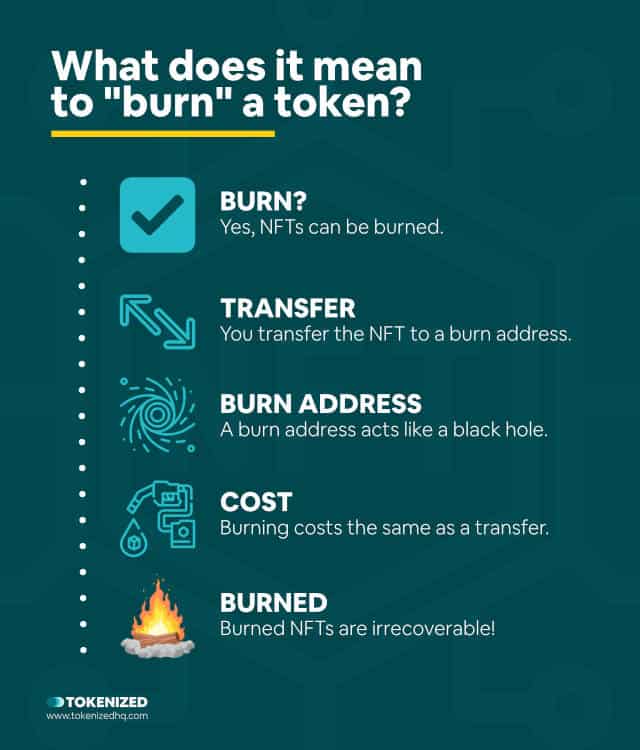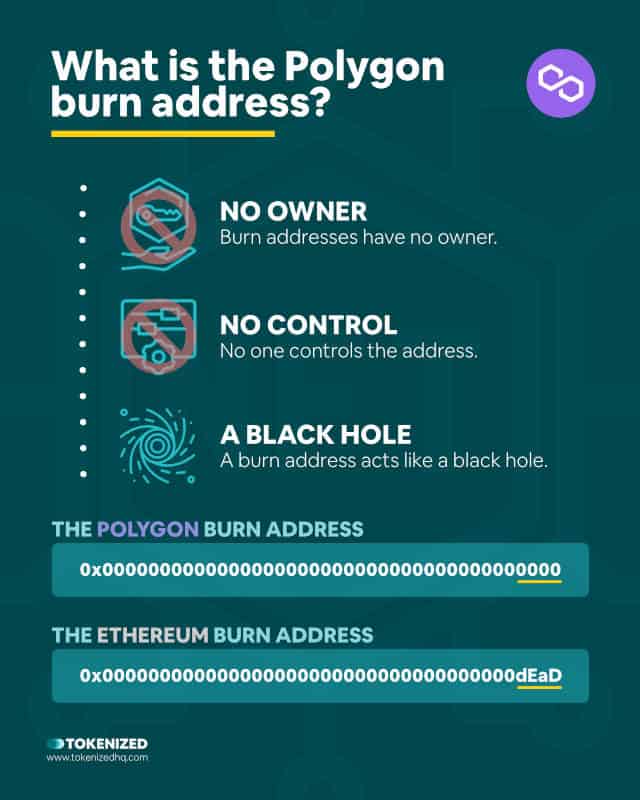Are you trying to find the correct Polygon burn address?
Perhaps you’re a bit confused because it seems like the burn address you’re used to on Ethereum is apparently different on Polygon?
Or maybe you heard that Polygon is implementing EIP-1559, a token burn mechanism that was first introduced by Ethereum?
Don’t worry, we’ve got you covered because we’ve done the necessary digging and have all the answers ready for you.
In this guide, you’ll learn everything you need to know about the new MATIC burn mechanism as well as what the official Polygon burn address is.
So let’s get started.
Key Points (tl;dr)
- To “burn” a token usually means that it is removed from the circulating supply of a cryptocurrency or NFT collection.
- Burning a token can happen via mechanisms integrated into smart contracts or by simply transferring it into a burn address.
- The official Polygon burn address is 0x0000000000000000000000000000000000000000
- Polygon has also recently implemented the same automatic burning mechanism for transaction fees as Ethereum, based on the EIP-1559 proposal.
For a detailed comparison of what the Polygon burn address is, PLEASE SCROLL FURTHER DOWN THE ARTICLE.
Like this content? Then share it!
Solved: The Correct Polygon Burn Address
www.tokenizedhq.com
Here’s the answer. Great article by @ChrisHeidorn right here: https://tokenizedhq.com/polygon-burn-address/
What Does It Mean to “Burn” a Token?
When a fungible token or an NFT is burned, it is either completely removed from the supply (thus also reducing the max supply) or transferred into an address that is not controlled by anyone, thereby reducing the circulating supply.

So you might have read about how tokens are sometimes burned, right?
And you’re probably wondering what exactly that means.
Both regular fungible tokens (such as Bitcoin), as well as NFTs, can be burnt.
When a token is burned, it is taken out of circulation and reduces the total amount of tokens that can be held by active addresses.
There are effectively 2 ways to burn tokens.
The first, easiest and most common way to burn an NFT is by simply transferring it to a burn address.
A burn address is a cryptocurrency address that is neither owned nor controlled by anyone.
This does not reduce the total supply of the currency or NFT collection, however, it effectively reduces the circulating supply.
If you’re curious to know more about how you can do this with NFTs, we recommend checking out our article on how to delete an NFT on OpenSea.
The more elegant way to burn tokens is by integrating such a mechanism straight into the underlying smart contract.
In some cases, the token may actually be deleted entirely, which would reduce the total supply.
In other cases, the burn mechanism transfers the tokens into a locked treasury fund.
What Is the Polygon Burn Address?
The official Polygon burn address is slightly different from that of Ethereum. Polygon’s burn address is 0x0000000000000000000000000000000000000000. Unlike on Ethereum, it does not end with the 4 letters “dEaD”.

Despite being a layer 2 solution on top of Ethereum as well as many other close similarities, you might be surprised to hear that the official Polygon burn address is not the same as on Ethereum.
Of course, technically any random address could be used as a burn address as long as no one knows the private keys.
However, if you want to be really sure, it’s advisable to use the official burn address of each blockchain.
If you’re familiar with our guide on how to burn NFT on OpenSea, then you probably already know what the Ethereum burn address looks like.
The Ethereum Burn Address
But here’s the surprise.
Even though Polygon tries to stick as close as possible to what Ethereum does, the official Polygon burn address is a bit different.
Instead of ending the address with the same four letters “dEaD”, the Polygon burn address ends with a simple “0000”.
The Polygon Burn Address
You can check out the address for yourself right here.
What Is the MATIC Burn Mechanism?
Polygon has implemented the EIP-1559 burn mechanism that was introduced by Ethereum in 2021 to increase mining speeds and counter potential inflationary effects of this change.
In 2021 Ethereum implemented an upgrade to its network based on the Ethereum Improvement Proposal EIP-1559.
The proposal was aimed at increasing the mining speed of its native currency Ether (ETH) by incentivizing it.
Since mining new Ether effectively increases the circulating supply and there is no hard cap on the total circulation, Ethereum needed a burning mechanism to counter this effect.
The EIP-1559 burning mechanism essentially takes base fees from transactions and removes them from circulation, thereby potentially boosting the token’s price.
In early 2022 Polygon decided to implement the very same burn mechanism for its MATIC token.
So every time you complete a transaction on Polygon, base fees are being burned and locked on the burn contract on Polygon.
Conclusion
Most of us have heard of the concept of “burning tokens” before but only a few of us have actually done it.
If you’re used to using the Ethereum and Polygon blockchains, it’s easy to assume that almost everything is similar.
That’s why it’s particularly important that you understand that in this particular case, the Polygon burn address actually differs from Ethereum’s.
Here at Tokenized, we want to help you learn as much as possible about the coming NFT revolution. We help you navigate this fascinating new world of non-fungible tokens and show you how you can integrate tokenization into your own business.



